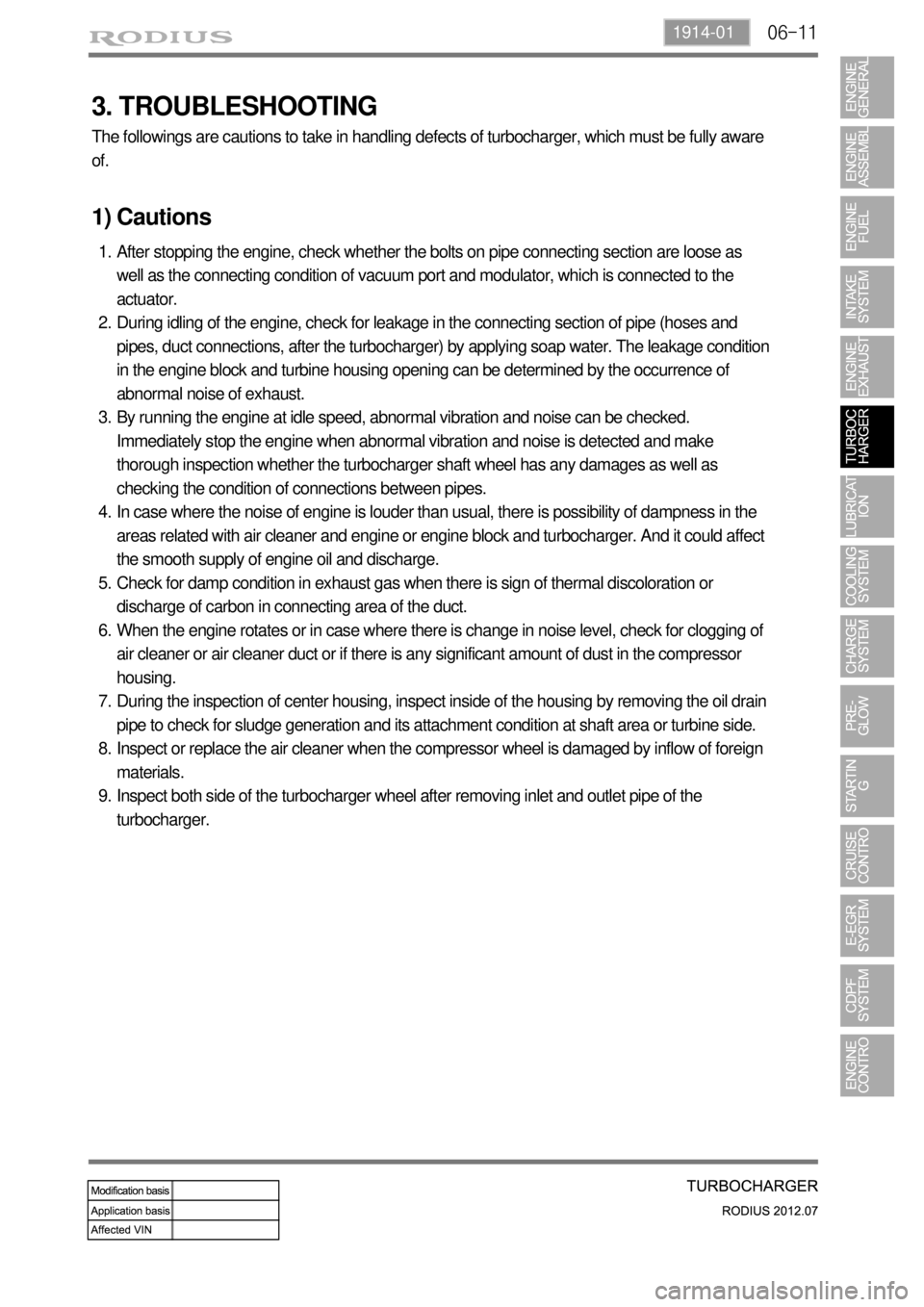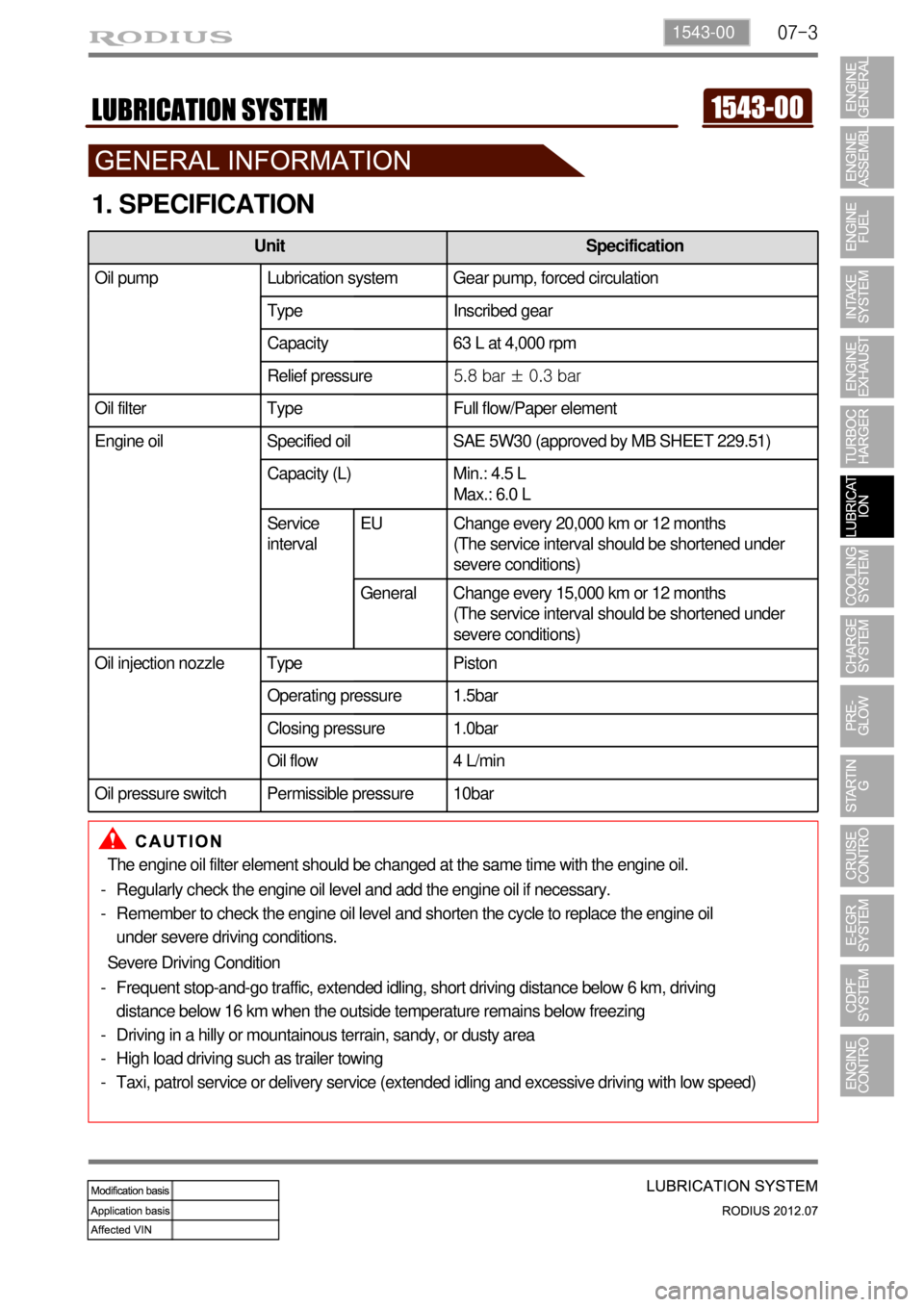Page 248 of 715
06-71914-01
4) Possible Causes of Defect
The following tries to understand the defects that can occur with vehicle installed with the
turbocharger and to manage the reasons of such defects.
In case where oil pan/oil pipe has been contaminated, oil filter is defected and where adhesive
of gaskets has been contaminated into the oil line. 1.
Page 249 of 715
06-8
Oil Pump Defect: Rapid over-loaded driving after replacing oil filter and oil and clogging of oil
line. 2.
Page 252 of 715

06-111914-01
3. TROUBLESHOOTING
The followings are cautions to take in handling defects of turbocharger, which must be fully aware
of.
1) Cautions
After stopping the engine, check whether the bolts on pipe connecting section are loose as
well as the connecting condition of vacuum port and modulator, which is connected to the
actuator.
During idling of the engine, check for leakage in the connecting section of pipe (hoses and
pipes, duct connections, after the turbocharger) by applying soap water. The leakage condition
in the engine block and turbine housing opening can be determined by the occurrence of
abnormal noise of exhaust.
By running the engine at idle speed, abnormal vibration and noise can be checked.
Immediately stop the engine when abnormal vibration and noise is detected and make
thorough inspection whether the turbocharger shaft wheel has any damages as well as
checking the condition of connections between pipes.
In case where the noise of engine is louder than usual, there is possibility of dampness in the
areas related with air cleaner and engine or engine block and turbocharger. And it could affect
the smooth supply of engine oil and discharge.
Check for damp condition in exhaust gas when there is sign of thermal discoloration or
discharge of carbon in connecting area of the duct.
When the engine rotates or in case where there is change in noise level, check for clogging of
air cleaner or air cleaner duct or if there is any significant amount of dust in the compressor
housing.
During the inspection of center housing, inspect inside of the housing by removing the oil drain
pipe to check for sludge generation and its attachment condition at shaft area or turbine side.
Inspect or replace the air cleaner when the compressor wheel is damaged by inflow of foreign
materials.
Inspect both side of the turbocharger wheel after removing inlet and outlet pipe of the
turbocharger. 1.
2.
3.
4.
5.
6.
7.
8.
9.
Page 264 of 715

07-31543-00
1. SPECIFICATION
The engine oil filter element should be changed at the same time with the engine oil.
Regularly check the engine oil level and add the engine oil if necessary.
Remember to check the engine oil level and shorten the cycle to replace the engine oil
under severe driving conditions. -
-
Severe Driving Condition
Frequent stop-and-go traffic, extended idling, short driving distance below 6 km, driving
distance below 16 km when the outside temperature remains below freezing
Driving in a hilly or mountainous terrain, sandy, or dusty area
High load driving such as trailer towing
Taxi, patrol service or delivery service (extended idling and excessive driving with low speed) -
-
-
-
Unit Specification
Oil pump Lubrication system Gear pump, forced circulation
Type Inscribed gear
Capacity 63 L at 4,000 rpm
Relief pressure5.8 bar ± 0.3 bar
Oil filter Type Full flow/Paper element
Engine oil Specified oil SAE 5W30 (approved by MB SHEET 229.51)
Capacity (L) Min.: 4.5 L
Max.: 6.0 L
Service
intervalEU Change every 20,000 km or 12 months
(The service interval should be shortened under
severe conditions)
General Change every 15,000 km or 12 months
(The service interval should be shortened under
severe conditions)
Oil injection nozzle Type Piston
Operating pressure 1.5bar
Closing pressure 1.0bar
Oil flow 4 L/min
Oil pressure switch Permissible pressure 10bar
Page 265 of 715

07-4
2. MAINTENANCE
1) Level Check
Park the vehicle on a level ground and apply the parking brake. Stop the engine and wait more than 5
minutes.
Pull out the dipstick and wipe it with a clean cloth. Reinsert it all the way.
Pull out it again and check the oil level.
The oil level should be between the maximum (Max) mark and minimum (Min) mark on the oil
dipstick. Oil should be replenished before the level goes below the minimum mark. -
-
-
Operating vehicle with insufficient amount of oil can damage the engine. Make sure the
engine oil level is correct and add oil if necessary.
2) Replenishment
If the level gets to the lower point, open the filler cap on top of the cylinder block and add the
genuine oil without exceeding the level of the upper mark.
Recheck the oil level after 5 minutes.
Regularly check the engine oil level and add Ssangyong genuine engine oil if necessary.
Clean the dipstick with clean cloth so that any foreign materials cannot get into the engine.
The oil should not go above the upper mark on the dipstick.
The engine oil may be consumed more if the engine is new. -
-
-
-
Engine oil dipstick
Engine oil filler
Page 266 of 715
07-51543-00
1. SYSTEM DESCRIPTION
1) Overview
The lubrication system supplies oil to each lubrication section to prevent friction and wear and to
remove heat from the friction part. As the engine runs, frictional heat is generated on each
lubrication section. If this condition persists, the bearing can be burned and stuck.
In other words, it creates an oil film on each sliding surface to convert solid friction to liquid
friction in order to minimize wear and prevent temperature increasing on the friction part.
For the D20DTF engine with no oil pressure switch, the engine ECU receives the low engine oil
level signal from the oil level sensor and communicates with the instrument cluster through the
CAN communication to turn on the warning lamp.
2) Components
Oil coolerOil dipstick gaugeOil pump
Oil filter moduleOil pressure switchOil pan
Page 267 of 715

07-6
2. FUNCTIONS OF LUBRICATION
1) Lubrication
It creates a viscous barrier between moving parts that reduces friction, which means less heat
and longer life for those parts. As a lubricant, oil must maintain a protective film to prevent metal-
to-metal contact. It must be fluid enough to allow easy starting and to circulate quickly through
the engine, yet remain thick enough at higher operating temperatures and speeds to provide
adequate lubrication.
2) Cooling
Combustion heat and friction energy must be removed from the engine in order to prevent its
overheating. Most of heat energy is taken by the engine oil.
Clean oil passages, proper viscosity and low contamination provide sufficient flow rate of the
engine oil and effective cooling.
3) Sealing
It helps to seal the space between the pistons and the cylinder walls so that compression is more
effective and power is not lost during combustion.
4) Anti-corrosion
As a corrosion inhibitor, oil coats internal engine parts to prevent surface rust on the inside of the
engine which can be caused by blow-by products and water formed in combustion. It must also
be capable of neutralizing the acids that are formed by combustion blow-by and oil oxidation at
high temperatures.
5) Cleaning
The small particles of dirt or other contaminants are suspended in oil and carried away to be
filtered out. As a detergent, engine oil must be able to gather and suspend dirt and other
contaminants until the oil can leave them as it passes through the filter and returns to the internal
engine environment.
Page 273 of 715
08-8
Coolant reservoir
Oil filter module
Thermostat
When the engine coolant
reaches 90℃, the thermostat
starts to open (fully open at
100℃) and lets the coolant
flow to the radiator to
maintain the engine
temperature.
Water pump
The water pump is driven by the engine drive belt and
supplies the coolant to each area of the engine.
1. SYSTEM DESCRIPTION
1) Overview
Water pump Impeller vaneSealing